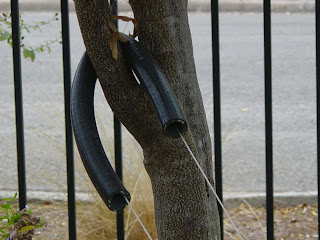Bucket Handle
Turning an old hose into a bucket handle can be very helpful. The original handles are usually made from a rigid plastic that is not very comfortable on the hand and generally, does not hold up for very long. To make a bucket handle, start with a section of hose, a good pair of scissors, strong tape, and some buckets or containers that need new handles.
Cutting the hose can be difficult. I really like the Fiskars kitchen shears for this job. The kitchen shears have a special design for cutting through bone which makes them pretty handy. A box cutter can also work well if you don't have sharp, heavy duty scissors. Cut the hose in 3 - 4 inch lengths for a standard 5 gallon bucket.
Slice through the hose segment lengthwise, then slide onto the bucket handle.
Run a strip of tape around the hose to secure it to the handle. Be sure to completely cover the cut portion of the hose.
The finished handle will get more comfortable with use. Additional layers of tape can help smooth out any bothersome creases.
Tree Protector (when staking)
Staking a tree is usually not recommended, however, there are times when staking may be necessary. I purchased a yellow flowering Texas senna because I wanted to attract the cloudless sulfur butterfly. My intention was to grow the plant as a tree, but before I could get started with training, the plant decided to be a bush. I tried to convince the plant it was a tree, but all that did was confuse it. In the process of removing the multi-trunking branches, I weakened it to the point where it would not stand on it's own and staking was required.
Rather than wrap the twine directly around the tree, I fed the twine through a length of hose. A large saftely pin is a handy way to feed the twine through the hose. The hose is soft and pliable and will not damage the bark as easily as the twine would.
Eventually the twine can be loosened to test if the tree is ready to stand on it's own.









No comments:
Post a Comment